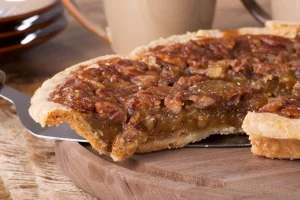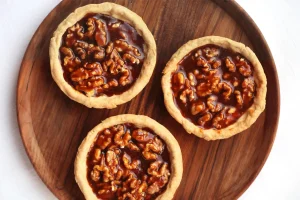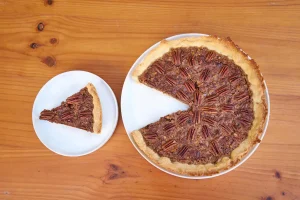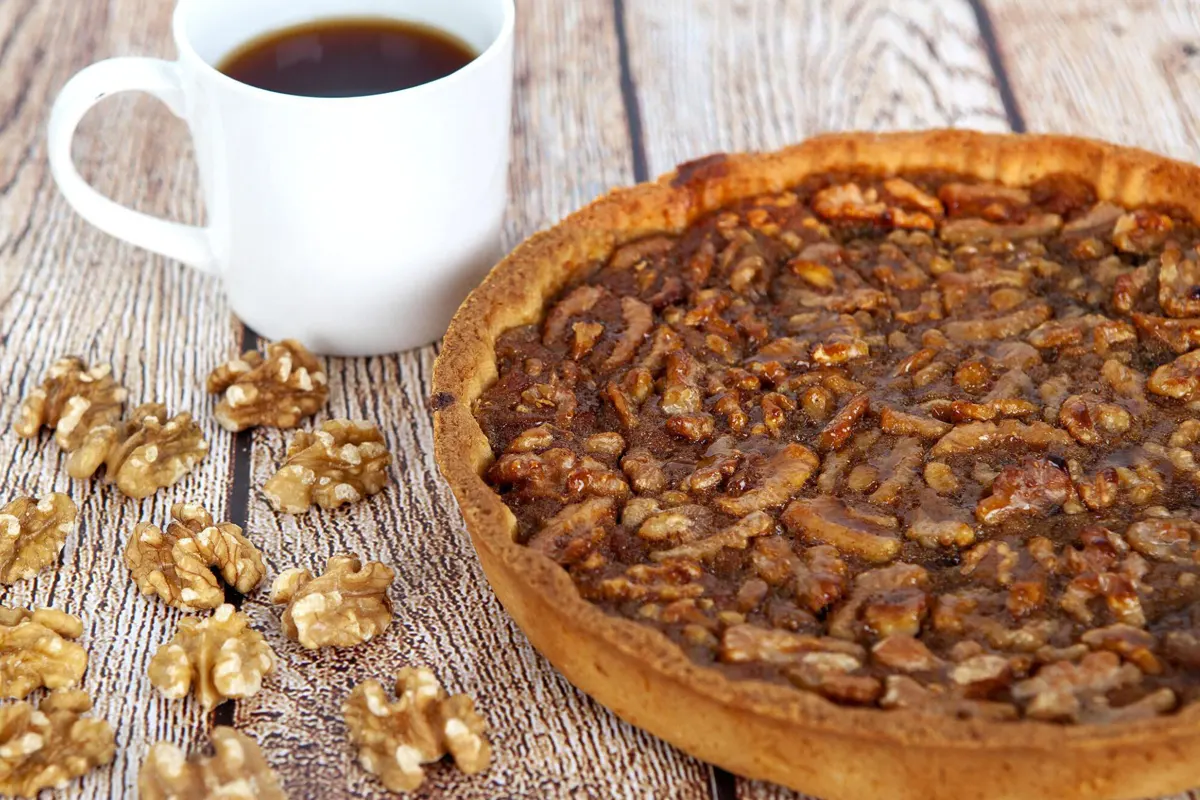Diving into the world of traditional desserts brings us to a timeless classic that stands out with its unique blend of flavors and textures – the pecan pie. Renowned for its sweet and salty harmony, this dessert has carved its niche in the hearts of baking aficionados and dessert lovers alike. In this article, we embark on a culinary journey to explore the quintessential pecan pie, from its roots steeped in tradition to the modern twists that continue to enchant our palates. We’ll uncover the secrets to achieving that perfect pecan pie jiggle, delve into the science behind the ingredients, and offer tips for serving, storing, and elevating your pie to new heights. Whether you’re a seasoned baker or a curious novice, join us as we celebrate the art of pecan pie making, ensuring your next pie is not just good, but spectacular.
Introduction to Pecan Pie
Ah, pecan pie – a name that conjures images of festive gatherings and cozy afternoons. But what’s the story behind this beloved dessert, and why does it continue to capture our culinary imagination?
The Cultural Significance of Pecan Pie
Pecan pie is more than just a dessert; it’s a slice of cultural heritage, akin to the globally recognized traditional foods highlighted by the Food and Agriculture Organization of the United Nations (FAO) for their significance in various cultures. Its rich history is a tapestry woven with the flavors of generations, each adding their own touch to this iconic recipe.
Brief History and Traditional Aspects
The origins of pecan pie are as rich and varied as its filling. While pecans have been used by Native Americans for centuries, the sweet pie we know today likely originated in the late 19th century. It gained prominence when corn syrup became widely available, offering a simpler way to create the pie’s signature gooey filling.
Overview of the Article Contents
In this article, we’ll guide you through the steps to create the ultimate pecan pie, from selecting high-quality pecans to mastering the flaky crust. We’ll address the burning question, “Should pecan pie jiggle when done?” and reveal the techniques to ensure your pie is just right. Along the way, we’ll sprinkle in tips for variations, storage, and presentation, making sure your pecan pie is the talk of the table.
Stay tuned as we dive into the heart of pecan pie making, where tradition meets technique, and every slice tells a story. Join us on this delicious journey, and let’s bake a pie that would make Grandma proud.

The Perfect Pecan Pie Recipe
When it comes to the heartwarming world of pies, pecan pie stands out with its rich, nutty flavor and irresistibly sticky sweetness. But what truly sets a pecan pie apart is not just the ingredients but the love and care baked into every slice. In this section, we’ll walk you through a cherished recipe that has warmed many a kitchen and heart, ensuring your pie is nothing short of perfection.
Ingredients Overview
At the core of any memorable pecan pie are, undoubtedly, the pecans themselves. Opting for high-quality pecans is not just a suggestion; it’s a necessity to capture the pie’s soulful essence. Alongside these star nuts, other key players like eggs, corn syrup, and brown sugar come into play, each adding layers of flavor and texture.
High-Quality Pecans: The Non-Negotiable
The pecans are the pièce de résistance of your pie, offering that signature crunch and depth of flavor. It’s crucial to select the finest pecans, as they are the backbone of this culinary masterpiece.
Sweet Synergy: Corn Syrup and Brown Sugar
The duo of corn syrup and brown sugar creates a luscious filling, with the syrup ensuring a smooth texture and the sugar adding a comforting, caramel note. Dark or light, each type of brown sugar brings its own unique melody to the symphony of tastes.
Step-by-Step Recipe Guide
Crafting the perfect pecan pie is akin to conducting an orchestra, with each ingredient playing its part in harmony.
Crust: The Foundation
Begin with a flaky, buttery crust – your pie’s foundation. A well-made crust sets the stage for the luscious filling to shine. Remember, patience is key when chilling and rolling out your dough to achieve that dreamy flakiness.
Filling: The Heart
Mix your filling with a gentle hand, ensuring the eggs, syrup, and sugar meld together in a sweet embrace. Pour this golden mixture over your carefully arranged pecans, and watch as it sets to create the pie’s gooey heart.
Baking: The Transformation
As your pie bakes, a magical transformation occurs. The filling bubbles up, the pecans toast to perfection, and the crust turns a delectable golden brown. This is the moment when the aromas envelop your kitchen, heralding the creation of something truly special.

Variations and Substitutions
For those seeking a twist on tradition, a maple pecan pie offers a delightful variation. Substituting pure maple syrup for corn syrup introduces a woodsy sweetness, making each bite a new discovery.
Diet-Friendly Adjustments
In today’s inclusive culinary landscape, adjustments for different dietary needs are more than possible; they’re a creative challenge. Gluten-free crusts, alternative sweeteners, and even vegan adaptations ensure everyone can enjoy a slice of this timeless classic.
In crafting this quintessential pecan pie, we embrace tradition while welcoming innovation. The result? A dessert that’s as rich in history as it is in flavor, promising to be the centerpiece of any gathering. And as for that age-old question, “Should pecan pie jiggle when done?” Indeed, a slight jiggle signifies that your pie is baked to perfection, with the center setting beautifully as it cools. So, go ahead, preheat your oven and ready your apron; a baking adventure awaits.
The Science of the Perfect Jiggle
Ah, the pecan pie jiggle, a dance of dessert perfection that’s as tantalizing to the eyes as it is to the palate. But what’s the secret behind that just-right jiggle, you ask? Well, strap in, because we’re diving into the nitty-gritty, the almost magical realm where baking meets science.
Understanding the Role of Eggs and Corn Syrup
First things first, let’s talk about the dynamic duo in pecan pie: eggs and corn syrup. These aren’t just any ingredients; they’re the cornerstone of the pie’s structure. Eggs, those humble kitchen staples, are the real MVPs here. They act like the glue, binding everything together. As they cook, they coagulate, giving the pie filling that firm yet slightly wobbly texture we all adore.
And corn syrup? It’s not just there for the sweetness, oh no. It plays a crucial role in preventing sugar crystallization, ensuring the filling is smooth as silk. Plus, it adds to the viscosity, contributing to that perfect jiggle. So, when someone asks, “Should pecan pie jiggle when done?” you bet your bottom dollar it should, but just a tad, like a gentle nod to its impeccable texture.
How Temperature Affects the Set and Jiggle
Temperature, the unseen hand guiding the fate of your pie, is paramount. Too high, and you risk a filling that’s scrambled rather than smooth; too low, and you’ll be left with a runny center that refuses to set. The goal? A pie that’s baked just enough so the center jiggles slightly when given a gentle nudge.
This is where patience plays a part. Once out of the oven, the pie needs to cool down gradually. It’s during this time that the magic happens, the filling sets further, and that coveted jiggle stabilizes into the perfect consistency.
Tips for Achieving the Perfect Texture
Achieving that perfect jiggle isn’t just luck; it’s an art and a science. Here are some golden nuggets of wisdom to help you nail it every time:
- Mind the Baking Time: Keep a keen eye on the clock. Overbaking is the nemesis of the perfect jiggle. When the pie’s edges are set but the center slightly jiggles, it’s time to pull it out.
- Use a Water Bath: Consider baking your pie in a water bath. This little trick helps regulate the temperature, ensuring even cooking and that just-right jiggle.
- Let It Rest: Patience, dear baker. Let the pie cool slowly at room temperature, then chill it in the fridge. This gradual cooldown helps the pie set without losing its jiggle.
In the grand tapestry of baking, the pecan pie jiggle is a testament to the baker’s skill, a dance of ingredients and temperatures that culminates in a dessert that’s nothing short of a masterpiece. So, the next time you bake a pecan pie, remember: it’s not just about the ingredients; it’s about understanding the science behind the jiggle.

Serving and Storage Tips
When it comes to pecan pie, half the fun is in the presentation and the anticipation of that first bite. But, equally important is ensuring that your pie is stored correctly, preserving that delightful jiggle and rich flavor for when it’s time to indulge. Here, we’ll dive into the essential tips for serving and storing your pecan pie, ensuring it remains the star of the dessert table.
Serving Pecan Pie Like a Pro
Ah, the moment of truth! Serving pecan pie is more than just slicing; it’s about creating an experience. Begin by considering the temperature. While some swear by the warmth of a freshly baked pie, others find the flavors more pronounced when it’s cool. Frankly, there’s no wrong answer here. Whether warm or at room temperature, each slice should be a journey through crisp, flaky crusts and into the sweet, nuanced depths of the filling.
Don’t shy away from accompaniments! A dollop of whipped cream or a scoop of ice cream can transform each serving from mere dessert to a decadent treat. But remember, the pie is the star, so let these additions support rather than overshadow its flavors.
Storing Your Pecan Pie
After the last guest leaves and the kitchen lights dim, storing your pecan pie correctly ensures that the remaining slices are just as inviting tomorrow. If you’re wondering, “Should pecan pie jiggle when done?” rest assured, a slight jiggle is just right, but proper storage is key to maintaining that perfect texture.
For short-term storage, covering your pie with plastic wrap or aluminum foil and keeping it at room temperature works for a day or two. However, for longer storage, the refrigerator is your friend. Here, your pie can comfortably rest for up to four days, shielded from air and moisture. Just ensure it’s wrapped tightly to keep out any fridge odors.
Freezing for the Future
For those who love to plan ahead or find themselves with an abundance of pie, freezing is a fantastic option. Once completely cooled, wrap your pie securely in plastic wrap, followed by a layer of aluminum foil. Stored in a freezer-safe container, your pie will wait patiently for up to three months, ready to be revived for your next craving. Thawing is as simple as a night in the refrigerator, followed by a brief room temperature rest before serving. This method not only preserves the pie’s flavors and textures but also encapsulates the joy of baking day, ready to be relived.
By adhering to these serving and storage tips, your pecan pie not only becomes a treat for the senses but also a testament to your care and craftsmanship in baking. After all, isn’t the true joy of baking found in the smiles of those we share our creations with? So, go ahead, bake with love, serve with pride, and store with care, knowing that each slice of pecan pie carries with it a story worth savoring.
Common Pecan Pie Mistakes to Avoid
Alright, let’s huddle up, team! We’re about to dive into the pecan pie playbook to sidestep those pesky pitfalls that can turn your masterpiece into a mayday situation. Pecan pie, with its gooey filling and crunchy top, might seem straightforward, but a few missteps can lead to a dessert disaster. So, buckle up as we navigate through the common blunders to keep your pie in tip-top shape.
Over or Under-Baking: The Timing Tango
First on the docket is the classic timing tango. Yes, pecan pie should have that dreamy jiggle, but there’s a fine line between perfectly set and pecan pudding. An over-baked pie can turn your filling into a chewy mess, robbing it of its signature smoothness. On the flip side, an under-baked pie won’t set properly, leaving you with a soupy center that makes for a sad slice.
The golden rule? Keep a keen eye on the clock and your pie. Look for that slight jiggle in the center—it means your pie is just right. And remember, patience is a virtue. Let your pie cool completely to achieve the ideal texture. It might test your willpower, but it’s worth the wait!
The Crust Conundrum: Soggy Bottoms and Burnt Edges
Next up, let’s tackle the crust conundrum. A soggy bottom can feel like a betrayal, especially after you’ve put so much love into your pie. The trick to avoiding this is ensuring your oven is hot enough when the pie goes in, setting that crust up for success.
Burnt edges, on the other hand, are like unwanted guests at a party. They show up uninvited and can ruin the fun. To keep those edges looking lovely, consider using a pie shield or a bit of aluminum foil to protect them. It’s like giving your pie a little armor against the heat.
Ingredient Imbalance: The Ratio Riddle
Lastly, we’re decoding the ratio riddle. Pecan pie is all about harmony—between the sweet and the salty, the gooey and the crunchy. An imbalance, like too much sugar or not enough pecans, can throw off the entire ensemble. Ensure you’re measuring your ingredients with precision, and don’t shy away from a generous helping of pecans. After all, it’s not called pecan pie for nothing!
Steering clear of these common mistakes will have you baking with confidence and, more importantly, enjoying every single bite of your pie. Keep these tips in your apron pocket, and you’re sure to be the pecan pie champion, no ifs, ands, or nuts about it!
FAQs
In the world of pecan pie making, questions abound. Whether you’re a seasoned baker or a first-timer looking to impress at your next gathering, there are always little nuggets of wisdom to glean. So, let’s dive into some of the most burning questions about pecan pie, ensuring your next creation is nothing short of spectacular.
Can Pecan Pie Be Made Without Corn Syrup?
This is a hot topic in the pecan pie community. Traditionalists might say, “No way, José!” But guess what? There’s room for innovation in every tradition. While corn syrup is the classic choice for that gooey, sweet filling, alternatives like pure maple syrup can add a delightful twist. The key is to balance the sweetness and texture. So, yes, you can break away from corn syrup, but tread thoughtfully to maintain that signature pecan pie charm.
How Do You Know When the Pie Is Perfectly Baked?
Ah, the age-old question: “Should pecan pie jiggle when done?” The answer is a resounding yes, but with a caveat. You’re looking for a slight jiggle, just in the center of the pie. This wiggle indicates that the filling is set but still has that luxurious, soft texture. Once out of the oven, the pie will continue to cook a bit from residual heat, reaching pie perfection as it cools.
Tips for a Flaky Pie Crust Every Time
The crust can make or break a pecan pie. For that enviable flakiness, keep your fats (butter or shortening) cold and your water ice-cold. This ensures those tiny fat pockets remain intact, creating layers of flaky goodness. And when rolling out your dough, be gentle. Overworking the dough develops gluten, which can lead to toughness. Treat it with care, and you’ll be rewarded with a crust that’s the perfect foundation for your pecan filling.
Navigating these FAQs can elevate your pecan pie from great to extraordinary. Remember, baking is part science, part art, and entirely an act of love. So, embrace these questions and answers as you embark on your next baking adventure. With each pie, you’re not just creating a dessert; you’re crafting a memory, one delicious slice at a time.
Advanced Baking Techniques and Presentation Ideas
Stepping into the realm of pecan pie mastery requires a dash of creativity and a sprinkle of skill. Once you’ve nailed the basics, it’s time to elevate your pie to showstopper status. Whether it’s for a special occasion or you’re simply looking to impress your fellow pie aficionados, these advanced techniques and presentation ideas will ensure your pecan pie is the belle of the ball.
Decorative Crust Designs
A pie’s crust isn’t just a vessel for the filling; it’s a canvas waiting for your artistic touch. Beyond the classic lattice, consider braided edges or leaf-shaped cutouts to adorn the crust’s rim. With a little patience and a few cookie cutters, you can transform your pie into an edible work of art. Imagine a ring of intricately designed leaves or a delicate braid encircling the sumptuous pecan filling – it’s enough to make anyone’s heart flutter.
Creative Serving Suggestions
When it comes to serving, presentation is key. Elevate the humble pie slice by drizzling a pure maple syrup glaze atop each piece, adding not only a touch of elegance but also an extra layer of flavor. Pair each slice with a quenelle of homemade whipped cream, subtly infused with vanilla or cinnamon for a complementary taste that enhances the pie’s nutty richness.
Advanced Baking Tips for the Perfect Pie
For those looking to dive deeper into the science of pie baking, consider the effects of different fats on your crust. Experimenting with a blend of butter for flavor and shortening for texture can lead to a crust that’s both flavorful and flaky. And when it comes to the filling, a dash of bourbon or a sprinkle of orange zest can introduce complex notes that dance on the palate, adding depth to the traditional pecan pie profile.
Mastering these advanced techniques and presentation ideas requires a bit of practice, but the results are well worth the effort. Each pie becomes a testament to your skill and creativity, a dessert that delights both the eyes and the taste buds. So, don your apron, unleash your inner artist, and let your pecan pie be the crowning glory of your culinary repertoire.
Conclusion and Call to Action
As we wrap up our journey through the art and science of crafting the perfect pecan pie, it’s clear that this beloved dessert is more than just a treat—it’s a tradition, a canvas for creativity, and a testament to the joy of baking. From mastering the perfect jiggle to designing a pie crust that could rival any masterpiece in an art gallery, pecan pie offers endless opportunities for expression and experimentation.
Whether you’re a seasoned baker or someone just starting to explore the wonders of the kitchen, remember that every pie is a story, a blend of technique, tradition, and personal touch. The beauty of baking lies in its ability to bring people together, to create moments of joy and connection over a slice of something sweet and homemade.
So, I encourage you to take these tips, techniques, and ideas and make them your own. Experiment with flavors, play with presentation, and above all, share your creations with those you love. Baking is an act of love, a gift that keeps on giving, and what better way to spread a little sweetness in the world than with a perfectly crafted pecan pie?
Now, it’s your turn. Roll up those sleeves, tie on your apron, and get ready to create some magic in the kitchen. And when you do, don’t forget to share your stories, your successes, and even your flops. Because every baker knows, it’s all part of the journey. Happy baking, and here’s to the many pies that lie ahead in your baking adventures!

